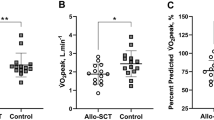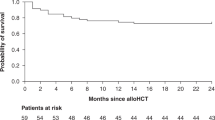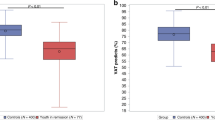Abstract
The feasibility of symptom-limited cardiopulmonary exercise testing (CPET) prior to allo-SCT was assessed in addition to the prognostic value of CPET-derived measures. CPET was performed prospectively on 21 patients with hematologic malignancies, with assessments of peak (for example, peak oxygen consumption, VO2peak) and submaximal (for example, ventilatory threshold (VT)) measures of cardiopulmonary function. No serious adverse events were observed during CPET procedures, with 95% of patients achieving criteria for a peak test. Mean VO2peak was 24.7±6.4 mL kg−1min−1 (range: 10.9–35.5), equivalent to 29%±17% below that of age-matched healthy controls. All patients proceeded with the conditioning regimen followed by allo-SCT. Median follow-up was 25 months. During this period, 11 (52.4%) patients died (n=6, relapsed disease; n=5, non-relapse mortality (NRM)); 9 patients (43%) developed pulmonary toxicity. In univariate analyses, both peak and submaximal markers of cardiopulmonary function were predictors of OS, pulmonary toxicity and NRM. For OS, the HR for VO2peak and VT were 0.89 (95% CI, 0.8–0.99, P=0.04) and 0.84 (95% CI, 0.71–0.98, P=0.03), respectively. In conclusion, CPET is safe and feasible prior to allo-SCT. Patients have marked impairments in cardiopulmonary function prior to allo-SCT. CPET-derived metrics may complement conventional measures to improve risk stratification.
This is a preview of subscription content, access via your institution
Access options
Subscribe to this journal
Receive 12 print issues and online access
$259.00 per year
only $21.58 per issue
Buy this article
- Purchase on Springer Link
- Instant access to full article PDF
Prices may be subject to local taxes which are calculated during checkout
Similar content being viewed by others
References
Doocey RT, Toze CL, Connors JM, Nevill TJ, Gascoyne RD, Barnett MJ et al. Allogeneic haematopoietic stem-cell transplantation for relapsed and refractory aggressive histology non-Hodgkin lymphoma. Br J Haematol 2005; 131: 223–230.
Fielding AK, Rowe JM, Richards SM, Buck G, Moorman AV, Durrant IJ et al. Prospective outcome data on 267 unselected adult patients with Philadelphia chromosome-positive acute lymphoblastic leukemia confirms superiority of allogeneic transplantation over chemotherapy in the pre-imatinib era: results from the International ALL Trial MRC UKALLXII/ECOG2993. Blood 2009; 113: 4489–4496.
Sorror ML, Storer BE, Maloney DG, Sandmaier BM, Martin PJ, Storb R . Outcomes after allogeneic hematopoietic cell transplantation with nonmyeloablative or myeloablative conditioning regimens for treatment of lymphoma and chronic lymphocytic leukemia. Blood 2008; 111: 446–452.
Sureda A, Robinson S, Canals C, Carella AM, Boogaerts MA, Caballero D et al. Reduced-intensity conditioning compared with conventional allogeneic stem-cell transplantation in relapsed or refractory Hodgkin's lymphoma: an analysis from the Lymphoma Working Party of the European Group for Blood and Marrow Transplantation. J Clin Oncol 2008; 26: 455–462.
Devergie A, Blaise D, Attal M, Tigaud JD, Jouet JP, Vernant JP et al. Allogeneic bone marrow transplantation for chronic myeloid leukemia in first chronic phase: a randomized trial of busulfan-cytoxan versus cytoxan-total body irradiation as preparative regimen: a report from the French Society of Bone Marrow Graft (SFGM). Blood 1995; 85: 2263–2268.
Hartman AR, Williams SF, Dillon JJ . Survival, disease-free survival and adverse effects of conditioning for allogeneic bone marrow transplantation with busulfan/cyclophosphamide vs total body irradiation: a meta-analysis. Bone Marrow Transplant 1998; 22: 439–44309/11.
Kroger N, Zabelina T, Kruger W, Renges H, Stute N, Kabisch H et al. Comparison of total body irradiation vs busulfan in combination with cyclophosphamide as conditioning for unrelated stem cell transplantation in CML patients. Bone Marrow Transplant 2001; 27: 349–354.
Ringden O, Remberger M, Ruutu T, Nikoskelainen J, Volin L, Vindelov L et al. Increased risk of chronic graft-versus-host disease, obstructive bronchiolitis, and alopecia with busulfan versus total body irradiation: long-term results of a randomized trial in allogeneic marrow recipients with leukemia. Nordic Bone Marrow Transplantation Group. Blood 1999; 93: 2196–2201.
Kelsey CR, Horwitz ME, Chino JP, Craciunescu O, Steffey B, Folz RJ et al. Severe pulmonary toxicity after myeloablative conditioning using total body irradiation: an assessment of risk factors. Int J Radiat Oncol Biol Phys 2011; 81: 812–818.
Fujimaki K, Maruta A, Yoshida M, Sakai R, Tanabe J, Koharazawa H et al. Severe cardiac toxicity in hematological stem cell transplantation: predictive value of reduced left ventricular ejection fraction. Bone Marrow Transplant 2001; 27: 307–310.
Goldberg SL, Klumpp TR, Magdalinski AJ, Mangan KF . Value of the pretransplant evaluation in predicting toxic day-100 mortality among blood stem-cell and bone marrow transplant recipients. J Clin Oncol 1998; 16: 3796–3802.
Singh AK, Karimpour SE, Savani BN, Guion P, Hope AJ, Mansueti JR et al. Pretransplant pulmonary function tests predict risk of mortality following fractionated total body irradiation and allogeneic peripheral blood stem cell transplant. Int J Radiat Oncol Biol Phys 2006; 66: 520–527.
Crawford SW, Fisher L . Predictive value of pulmonary function tests before marrow transplantation. Chest 1992; 101: 1257–1264.
Zangari M, Henzlova MJ, Ahmad S, Scigliano E, Isola L, Platnik J et al. Predictive value of left ventricular ejection fraction in stem cell transplantation. Bone Marrow Transplant 1999; 23: 917–920.
Koelwyn GJ, Khouri M, Mackey JR, Douglas PS, Jones LW . Running on empty: cardiovascular reserve capacity and late effects of therapy in cancer survivorship. J Clin Oncol 2012; 30: 4458–4461.
Ewer MS, Lenihan DJ . Left ventricular ejection fraction and cardiotoxicity: is our ear really to the ground? J Clin Oncol 2008; 26: 1201–1203.
Jones LW, Eves ND, Haykowsky M, Freedland SJ, Mackey JR . Exercise intolerance in cancer and the role of exercise therapy to reverse dysfunction. Lancet Oncol 2009; 10: 598–605.
American Thoracic Society; American College of Chest Physicians. ATS/ACCP Statement on cardiopulmonary exercise testing. Am J Respir Crit Care Med 2003; 167: 211–277.
Jones LW, Courneya KS, Mackey JR, Muss HB, Pituskin EN, Scott JM et al. Cardiopulmonary function and age-related decline across the breast cancer survivorship continuum. J Clin Oncol 2012; 30: 2530–2537.
Jones LW, Hornsby WE, Goetzinger A, Forbes LM, Sherrard EL, Quist M et al. Prognostic significance of functional capacity and exercise behavior in patients with metastatic non-small cell lung cancer. Lung Cancer 2012; 76: 248–252.
Jones LW, Watson D, Herndon JE 2nd, Eves ND, Haithcock BE, Loewen G et al. Peak oxygen consumption and long-term all-cause mortality in nonsmall cell lung cancer. Cancer 2010; 116: 4825–4832.
Ruden E, Reardon DA, Coan AD, Herndon JE 2nd, Hornsby WE, West M et al. Exercise behavior, functional capacity, and survival in adults with malignant recurrent glioma. J Clin Oncol 2011; 29: 2918–2923.
Ruden E, Reardon DA, Coan AD, Herndon JE, Hornsby WE, Fels DR et al. Exercise behavior, functional capacity, and survival in adults with malignant recurrent glioma. J Clin Oncol 29: 2918–2923.
Kasymjanova G, Correa JA, Kreisman H, Dajczman E, Pepe C, Dobson S et al. Prognostic value of the six-minute walk in advanced non-small cell lung cancer. J Thorac Oncol 2009; 4: 602–607.
Wood WA, Deal AM, Reeve BB, Abernethy AP, Basch E, Mitchell SA et al. Cardiopulmonary fitness in patients undergoing hematopoietic SCT: a pilot study. Bone Marrow Transplant 2013; 48: 1342–1349.
Delwail V, Jais JP, Colonna P, Andrieu JM . Fifteen-year secondary leukaemia risk observed in 761 patients with Hodgkin's disease prospectively treated by MOPP or ABVD chemotherapy plus high-dose irradiation. Br J Haematol 2002; 118: 189–194.
Beaver WL, Wasserman K, Whipp BJ . A new method for detecting anaerobic threshold by gas exchange. J Appl Physiol 1986; 60: 2020–2027.
Arena R, Myers J, Aslam SS, Varughese EB, Peberdy MA . Technical considerations related to the minute ventilation/carbon dioxide output slope in patients with heart failure. Chest 2003; 124: 720–727.
Baba R, Nagashima M, Goto M, Nagano Y, Yokota M, Tauchi N et al. Oxygen uptake efficiency slope: a new index of cardiorespiratory functional reserve derived from the relation between oxygen uptake and minute ventilation during incremental exercise. J Am Coll Cardiol 1996; 28: 1567–1572.
Fitzgerald MD, Tanaka H, Tran ZV, Seals DR . Age-related declines in maximal aerobic capacity in regularly exercising vs. sedentary women: a meta-analysis. J Appl Physiol 1997; 83: 160–165.
Wilson TM, Tanaka H . Meta-analysis of the age-associated decline in maximal aerobic capacity in men: relation to training status. Am J Physiol Heart Circ Physiol 2000; 278: H829–H834.
Gibbons WJ, Fruchter N, Sloan S, Levy RD . Reference values for a multiple repetition 6-minute walk test in healthy adults older than 20 years. J Cardiopulm Rehabil 2001; 21: 87–93.
Godin G, Shephard RJ . A simple method to assess exercise behavior in the community. Can J Appl Sport Sci 1985; 10: 141–146.
Fletcher GF, Balady G, Froelicher VF, Hartley LH, Haskell WL, Pollock ML . Exercise standards. A statement for healthcare professionals from the American Heart Association Writing Group. Circulation 1995; 91: 580–615.
Skalski J, Allison TG, Miller TD . The safety of cardiopulmonary exercise testing in a population with high-risk cardiovascular diseases. Circulation 2012; 126: 2465–2472.
Scardovi AB, Coletta C, De Maria R, Perna S, Aspromonte N, Feola M et al. The cardiopulmonary exercise test is safe and reliable in elderly patients with chronic heart failure. J Cardiovasc Med 2007; 8: 608–612.
Win T, Jackson A, Groves AM, Sharples LD, Charman SC, Laroche CM . Comparison of shuttle walk with measured peak oxygen consumption in patients with operable lung cancer. Thorax 2006; 61: 57–60.
Beckles MA, Spiro SG, Colice GL, Rudd RM . The physiologic evaluation of patients with lung cancer being considered for resectional surgery. Chest 2003; 123: 105S–114S.
Beckles MA, Spiro SG, Colice GL, Rudd RM . Initial evaluation of the patient with lung cancer: symptoms, signs, laboratory tests, and paraneoplastic syndromes. Chest 2003; 123: 97S–104S.
Dales RE, Dionne G, Leech JA, Lunau M, Schweitzer I . Preoperative prediction of pulmonary complications following thoracic surgery. Chest 1993; 104: 155–159.
Lakoski SG, Eves ND, Douglas PS, Jones LW . Exercise rehabilitation in patients with cancer. Nat Rev Clin Oncol 2012; 9: 288–296.
Persoon S, Kersten MJ, van der Weiden K, Buffart LM, Nollet F, Brug J et al. Effects of exercise in patients treated with stem cell transplantation for a hematologic malignancy: a systematic review and meta-analysis. Cancer Treat Rev 2013; 39: 682–690.
Acknowledgements
LWJ is supported in part by research grants from the National Cancer Institute.
Author information
Authors and Affiliations
Corresponding author
Ethics declarations
Competing interests
The authors declare no conflict of interest
Rights and permissions
About this article
Cite this article
Kelsey, C., Scott, J., Lane, A. et al. Cardiopulmonary exercise testing prior to myeloablative allo-SCT: a feasibility study. Bone Marrow Transplant 49, 1330–1336 (2014). https://doi.org/10.1038/bmt.2014.159
Received:
Revised:
Accepted:
Published:
Issue Date:
DOI: https://doi.org/10.1038/bmt.2014.159
This article is cited by
-
Reduced cardiovascular reserve capacity in long-term allogeneic stem cell transplant survivors
Scientific Reports (2023)
-
Prehabilitative high-intensity interval training and resistance exercise in patients prior allogeneic stem cell transplantation
Scientific Reports (2023)
-
Impaired aerobic capacity in adolescents and young adults after treatment for cancer or non-malignant haematological disease
Pediatric Research (2023)
-
Preventing the adverse cardiovascular consequences of allogeneic stem cell transplantation with a multi-faceted exercise intervention: the ALLO-Active trial protocol
BMC Cancer (2022)
-
Cardiopulmonary performance in allogeneic hematopoietic cell transplantation recipients—evaluation of pre-transplant risk assessments
Bone Marrow Transplantation (2021)



